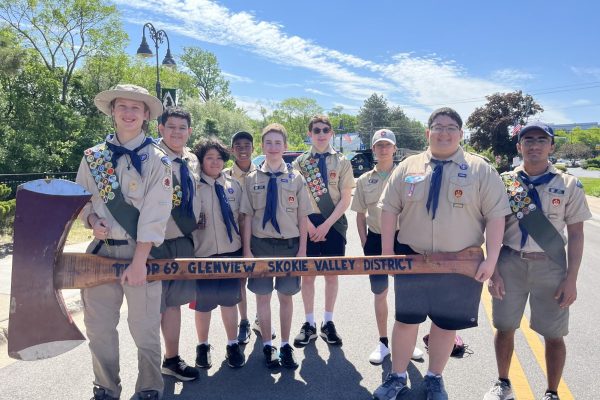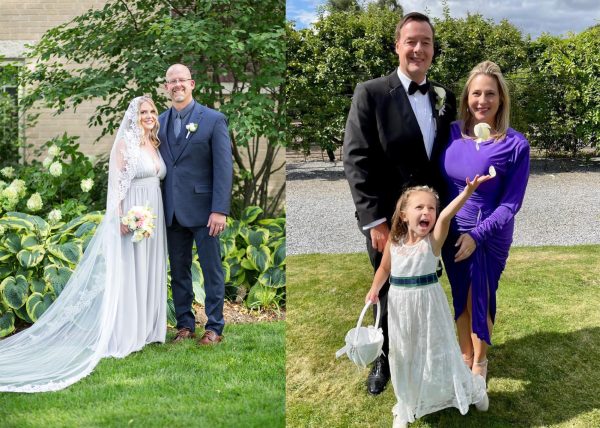Tattoos, piercings inspire self-expression
Body modification infuses connection with others
December 16, 2022
Please be advised the article below mentions sexual assault, which could potentially be triggering.
A body modification is defined as any method of permanently adorning the body, according to Dictionary.com. However, for senior Olivia Podyma, body modification means so much more.
Podyma currently has eight piercings and two tattoos with plans to get more of both. They have been experimenting with piercings since they were 16 and got a professional tattoo done on their 18th birthday. For Podyma, body modification is an important form of self-expression that they lacked when they were younger.
“I went to a Catholic [middle school], and you couldn’t have piercings,” Podyma said. “When I got to [South], I was really wowed by how much self-expression people had.”
Podyma decorates their body using body modification as a form of art. Podyma explained that each of their tattoos and piercings has symbolism and meaning. One of their tattoos includes the forget-me-not flower, which represents devotion and remembrance. Podyma also plans to get a tattoo of dandelions to represent growth and strength, they explained.
“Your body’s a temple, and you have to keep it decorated,” Podyma said. “You have to do what you [can] to keep it pretty.”
Each of senior Andrea Kim’s 11 tattoos have a powerful meaning. One tattoo, a ribbon, is a tribute to sexual assault victims inspired by a dance performed by her church’s dance team called “Another in the Fire”, Kim explained.
“[This dance] calls attention to sexual assault victims and they use [string] tightly tied around the dancer’s waists to represent each incident that occurs,” Kim said. “At the end of the dance [the dancers] tie [the string] into a ribbon to represent that it will always stay with you, but through Christ you can turn it into something beautiful.”
Body modifications are also a form of art to junior Sarah McMahon, who has 12 piercings. She started with simple ear piercings, but that quickly evolved as she continued to find joy in body modifications, McMahon explained. McMahon’s favorite piercings include the one in her septum and the one through her bellybutton. Body modifications act as a fun form of self-expression, she explained.
“Body modification to me means expressing yourself through art on your body,” McMahon said. “You express who you are, what you like, [and] your interests through that art.”
One of Podyma’s two tattoos is a stick and poke, which is a tattoo done without the use of a machine, just a needle and ink. Generally, stick and pokes are done unprofessionally at home or with friends. Even though it is not their highest quality tattoo, Podyma cherishes the sentimentality of it.
“Stick and pokes tend to have more meaning [than professional tattoos],” Podyma said. “It’s a bonding moment between you and your friends. It’s not usually a great tattoo, but it’s a fun memory, and I think it’s really sweet.”
Similarily to Podyma, Kim has also experimented with stick and pokes. She explained that her first few tattoos were stick and pokes done by her friend.
“I got matching [arrow stick and pokes on my] ankle with some of my childhood besties,” Kim said.
Body modification is not just for students, though. Matt Whipple, Social Studies Teacher, always wears a single gold earring. He has had the piercing since 1994, when his ex-girlfriend brought back a pair of handcrafted earrings from India. She wore one of the earrings and she pierced his ear so he could wear the other, Whipple explained. Even though they have gone their separate ways, Whipple has worn the earring in ever since.
“For me, the earring resonates in a very personal way about a very special person,” Whipple said. “It’s curious: I’m in touch with these moments from many years ago, [and] this earring takes me there.”
McMahon’s piercings also connect her with an important person in her life. Her older sister, who has around 40 piercings and dozens of tattoos, inspired McMahon to start her body modification journey. She appreciated how her sister was able to curate her piercings to match her style, and decided to follow along, McMahon explained.
“[My sister] is really what started my interest in getting piercings and exploring the realm of body modification,” McMahon said. “I feel like [it is] a big thing that bonds the two of us.”
However, body modifications are not for everybody. Many people are too hasty when selecting a tattoo or piercing and do not consider the consequences or permanence of them, sophomore Zellie Hammond said.
“I don’t think people think it through when they get [tattoos or piercings],” Hammond said. “There is ink on your body [or] a hole stabbed through you that’s stuck there now.”
One of the main problems with getting tattoos and piercings is the idea that they are perceived as unprofessional, Hammond explained. Large tattoos or multiple piercings are not common in the professional world, so having them can make it harder to get a job, Hammond said.
“I don’t think that people realize when they get tattoos or piercings that [they’re] making themselves unhireable,” Hammond said.
Though they have multiple piercings and tattoos, Podyma agrees that extreme body modifications are deemed “unprofessional”. However, they believe that this stigma can be lessened, especially as tattoos and piercings become normalized.
“[Body modification] is very stigmatized,” Podyma said. “No one thinks that tattoos are professional, but I think that if we start now, more people [will] get tattoos and then get professional jobs. [We can] slowly start to destigmatize [body modification].”
Professionalism is not the only stigma that exists around tattoos and piercings, either. When Whipple first got his piercing, many people assumed he was part of the LGBTQ+ community simply because he was wearing an earring, he explained. Although Whipple believed that this stigma has largely abated, Podyma explained that tattoos such as stick and pokes remain an important part of LGBTQ+ culture.
Body modifications have also been a large part of ethnic and tribal cultures throughout history, Whipple explained. Elites from ancient societies in the Middle East and South America have been depicted adorning their ears, and tattoos remain an important part of South Pacific Polynesian cultures, he described.
“There’s a lot of really cool cultural background to both tattoos and [piercings],” Whipple said. “It’s incredibly personal, powerful, and significant, and I don’t know that we take the time to [consider that]. [I got] my ear pierced, but so have millions of people throughout history. [I’m] not the first.”
Although tattoos and piercings can be beautiful and symbolic, getting one is still a big decision, Podyma said. They stressed the importance of doing proper research and consultation before committing to a potentially permanent addition to the body.
“Make sure you really want it before going out on a limb and do something impulsive,” Podyma said. “ Talk to a tattoo artist and get a consultation, or try fake piercings [first].”
McMahon’s piercings are an important part of her identity, so she does not appreciate it when someone judges her for them.
“Don’t hate on someone else for what they like and find interesting,” McMahon said. “Don’t yuck someone else’s yum.”
Podyma has also faced stigma for their body modifications, but they find comfort in the personal joy that their tattoos and piercings produce for them.
“I did it for me, and that’s what matters,” Podyma said.










